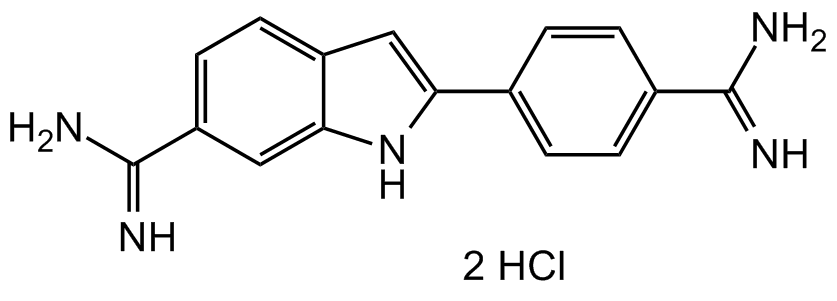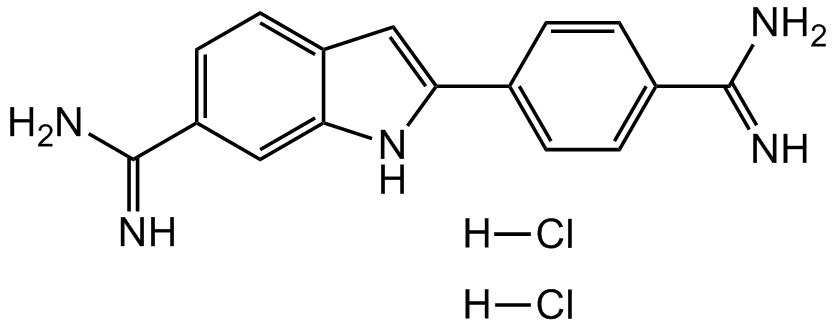
Chemical Structure
DAPI dihydrochloride Solution (10 mM in water)
CDX-D1217
CAS Number28718-90-3
Product group Chemicals
Estimated Purity>95%
Overview
- SupplierChemodex
- Product NameDAPI dihydrochloride Solution (10 mM in water)
- Delivery Days Customer10
- CAS Number28718-90-3
- CertificationResearch Use Only
- Concentration10 mM
- Estimated Purity>95%
- Scientific DescriptionChemical. CAS: 28718-90-3. Formula: C16H15N5 . 2HCl. MW: 350.25. DAPI (4,6-Diamidino-2-phenylindole dihydrochloride) is a cell permeable, fluorescent dye that is a minor groove-binding probe for DNA. Binds to the minor groove of double-stranded DNA (preferentially to AT rich DNA), forming a stable complex which fluoresces approximately 20 times greater than DAPI alone. DAPI is several times more sensitive than ethidium bromide for staining DNA in agarose gels. It may be used for photofootprinting of DNA, to detect annealed probes in blotting applications by specifically visualizing the double-stranded complex, and to study the changes in DNA and analyze DNA content during apoptosis using flow cytometry. DAPI staining has also been shown to be a sensitive and specific detection method for mycoplasma. Spectral Data: Excitation: lambdaex 340 nm; Emission: lambdaem 488 nm (only DAPI). Excitation: lambdaex 360nm; Emission: lambdaem 460nm (DAPI-DNA complex). - DAPI (4,6-Diamidino-2-phenylindole dihydrochloride) is a cell permeable, fluorescent dye that is a minor groove-binding probe for DNA. Binds to the minor groove of double-stranded DNA (preferentially to AT rich DNA), forming a stable complex which fluoresces approximately 20 times greater than DAPI alone. DAPI is several times more sensitive than ethidium bromide for staining DNA in agarose gels. It may be used for photofootprinting of DNA, to detect annealed probes in blotting applications by specifically visualizing the double-stranded complex, and to study the changes in DNA and analyze DNA content during apoptosis using flow cytometry. DAPI staining has also been shown to be a sensitive and specific detection method for mycoplasma. Spectral Data: Excitation: lambdaex 340 nm; Emission: lambdaem 488 nm (only DAPI). Excitation: lambdaex 360nm; Emission: lambdaem 460nm (DAPI-DNA complex).
- Storage Instruction-20°C,2°C to 8°C
- UNSPSC41116134



![DAPI [28718-90-3]](https://www.antibodies.com/image/catalog/319/A319637_1.jpg)
![DAPI Dihydrochloride [28718-90-3]](https://www.targetmol.com/group3/M00/35/78/CgoaEGayIC-EW36wAAAAAPsOgkI503.png)
